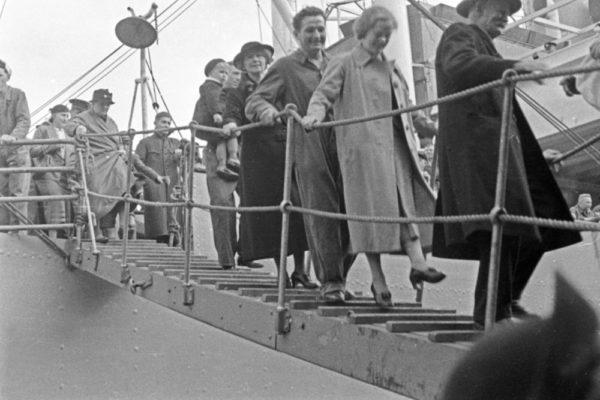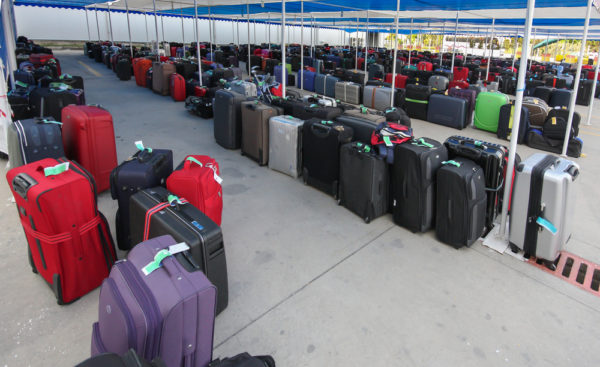
Disembarkation day is the final day of your cruise. When the time comes to disembark, this can be a sad and stressful experience. Not only is your vacation ending, but the process of actually leaving the cruise ship and getting back home can be filled with many unpleasant bumps.
For instance, you may encounter long wait times at several intervals — waiting for an elevator, waiting for your disembark group to be called, waiting in the line to exit the ship, waiting in customs line at the port, waiting for a taxi or other ground transportation, waiting at the airport.
You may also encounter logistical hurdles with managing your luggage, and corralling your kids. Or, you may experience sticker shock when you see the grand total on your final cruise bill. (All those extras can add up quickly!)
Take steps to minimize your stress and ease your family’s journey as you disembark. Here are our top strategies to a make your disembarkation day easier.
Top Tips To Disembark With Ease
1. Timely submit any requested disembarkation forms.
Planning for a smooth disembarkation day starts a few days before your actual last day on the ship. The cruise line will ask you to complete a short form with your departure details several days before the cruise ends. The cruise line uses this information to assign disembarkation groups.
Your assignment determines when you will be permitted to disembark the ship and when your luggage will be available in the cruise ship terminal. You want to be assigned to a disembark slot that fits with your ongoing travel plans, so be sure to turn in the form on time.
2. Review your financial accounts before disembarkation day.
At the end of the cruise, you will be provided with a copy of the charges that have been made to your ship account.You will inevitably see a very long line at guest services on the last day as people try to make adjustments or have issues with their bill.
You can avoid that line. Make a point of getting a copy of your bill midway through the trip to try and catch any problems early. As with a land-based hotel, you may be able to access a copy of your bill on the television in your stateroom.
Related Content: 7 Reasons Your Family Should Probably Skip That Cruise Drinks Package
3. Resolve any open tipping issues.
Most American-based cruise lines will add automatic gratuities to your account. This will be reflected as a daily fee assessed for each passenger in your stateroom (including children). These fees generally range from $12 to $18 per day, depending on cruise line and cabin category. All of the ship’s service staff shares in this tip pool. (Get more details in our post on what you need to know about cruise ship tipping.)
Sometimes you can select the “prepayment” of these automatic gratuities as a promotional perk at the time you book your cruise. Or, you may have the opportunity to pay in advance when you book your cruise.
Adjusting Automatic Gratuities
Your shipboard account will reflect charges for these gratuities unless pre-paid. If you do not wish to have your account handled in that manner, you have the option to visit guest services and have adjustments made as you believe appropriate.
Although this can be the topic of some controversy, it is usually the better practice to not attempt to remove or reduce the auto-gratuities. These gratuities are shared amongst a large number of crew including many folks who you may not personally interact with but who have worked diligently to provide your family with a happy cruise vacation. You will also save yourself a lot of time waiting in line at guest services.
Want to know more about the different points of view on cruise ship tipping? Find out more information here: USA TODAY’s guide to cruise ship gratuity charges. (“There perhaps is nothing more controversial in the world of cruising than the gratuity charge.”) Cruise Critic: Cruise Line Tipping Policies. (“Right up there with saving deck chairs and smoking on balconies, one of the most controversial topics of discussion among cruise passengers has always been tipping.”)
Distributing Cash Tips
You also have the option to provide individual cash gratuities to staff members who provided you with exemplary personal service that you would like to recognize. For instance, your stateroom attendant, your assigned table wait staff in the main dining room, a particularly attentive wine steward. This can be in addition to (or in lieu of) the ship-wide gratuities that are automatically assessed.
Typically, you will find small envelopes at guest services available for cash tips. Once you have decided who you should tip on your cruise, you can pass these out in person on the evening before disembarkation day.
4. Investigate luggage valet programs.
Find out whether your ship will offer any type of convenient luggage valet service. Depending on your cruise line, your ship, and the port where you disembark, it may be possible to have your luggage taken from the cruise ship and checked in with your airline. In cases where this is offered, the fees are relatively reasonable ($20-$25 per person).
You will not know prior to boarding whether you will be eligible for this service. Check with guest services early on in your cruise. If you can take advantage of such an option, you will streamline the process of getting out of the cruise terminal and to the airport to catch your flight on disembarkation day.
You can also arrange to have your luggage shipped from your home to the cruise ship before embarkation and then back home when you disembark through a luggage delivery service. These services can be extremely convenient, but expensive. You must arrange for such services well in advance of your initial departure (e.g., 30+ days).
Several third party companies offer this service, and some cruise lines like Princess and Cunard have also arranged to provide such services. You can find more information about these concierge style services here: https://allthingscruise.com/cruise-preparation/luggage-delivery-services/ and here (Shipping Luggage to Your Cruise: Is a Valet Service for You?) https://www.cruisecritic.com/articles.cfm?ID=464
5. Carefully review the written disembarkation procedures.
The day before your last full day on board, you should receive detailed information about the cruise line’s disembarkation procedures. Actually make a point to read this.
This information explains how the ship handles luggage, the available breakfast options, and where you can wait for your disembark group to be called. You will also learn about any required customs forms or other special port procedures.
6. Be mindful of how long it takes to disembark a cruise ship when making travel arrangements.
Just because the itinerary says that the ship arrives in port at a certain time doesn’t mean you will be allowed to exit at anywhere close to that time.
Customs and port authorities must be process the ship before any passengers disembark. The amount of time that takes involves factors outside the ship’s control.
To the extent possible, you should avoid making travel arrangements that allow less than a two hour window from the time the ship is scheduled to arrive in port.
7. If crunched for time, choose self-disembarkation.
Self-disembarkation, also known as express disembarkation, basically means that you manage all of your own luggage when departing the ship. It’s also sometimes referred to as a “self assist” or “walk off” procedure. If you have a modest amount of luggage and/or several able-bodied people in your party, this could be a viable option for you.
The people who self-disembark can leave the ship first. Everyone else must wait until their group is called.
But don’t be fooled by the reference to “express.” You may think that having to wrangle their own luggage and rise super early would be a disincentive to lots of people exercising this option. It’s not. So if you have aspirations of being one of the first ones off the ship, you need to start lining up very early. Like rock concert early.
8. Confirm that you can disembark with the right group.
If you are not planning to exercise a self disembarkation option, you should receive your luggage tags with the assigned group to disembark on the last full day of the cruise (which will often be a sea day). Review this information and confirm your assignment to a group that accommodates your onward travel plans.
You should also confirm that you have the correct luggage tags. If you see any problems with your assignment, visit guest services as soon as possible. If you need additional luggage tags, you can get them from your room attendant.
9. Plan for a disembarkation bag.
You will need to have your entire luggage packed up on the last night of your cruise and placed outside your stateroom by a designated time (unless you plan to carry it off yourself). You will not have access to your luggage again until after you have left the ship. So, you need to plan for a disembarkation bag.
What’s a disembarkation bag? Basically, it’s a small bag that you use to store all of the stuff that couldn’t make it into your luggage the night before.
So, for instance, you will need to leave out whatever sleepwear your family needs, your outfits for the next day, and any required toiletries. When you get ready to leave on the final morning, you will need a bag to store all of this stuff, as well as any last minute souvenirs, any photos you purchased, and any last minute things your kids may have picked up the night before.
A disembarkation bag is also a great place to store small activities that will entertain your kids during various waiting periods on disembarkation day. You will want something that you can easily tote around the ship — think hands free options and rolling options.
If you packed a carry on cruise bag for embarkation day, you could basically use the same bag and update the contents.
10. Arrange ground transportation in advance.
Finally, you should have a concrete plan for getting from the cruise terminal to the airport or hotel if you are staying over. There will literally be thousands of people disembarking during a relatively short time period. There can be an extensive wait for cabs. Consider making alternative arrangements.
Even if you don’t have to rush and catch a plane, standing in a long taxi line in the heat surrounded by your luggage and small children is not a fun way to end your vacation.
And, if you are disembarking at one of the Florida cruise ports, make sure that your taxi is actually an exclusive taxi rather than a shared ride. This is particularly true, if you are in a hurry.
The cruise line will offer a shuttle service (for a fee) that will consist of a large bus. You can book this while onboard, but you will need to make reservations in advance.
You can also arrange for a car service or van service to pick you up and take you to your hotel or the airport. This can be an ideal option when you are traveling with lots of luggage. Depending on the size of your party, a private transport can actually be cheaper overall than the multiple per person fees assessed for the cruise line shuttle.
Closing Thoughts:
These simple tips will help you streamline your disembarkation process. So that you can hold on to the warm glow of your cruise vacation as long as possible!
Keep up with the latest cruise tips and insights! Follow us on Pinterest:
Are you planning a cruise vacation with your family? We have a prep and pack checklist that is specifically designed to help families cruising with kids. Get your free copy now!







